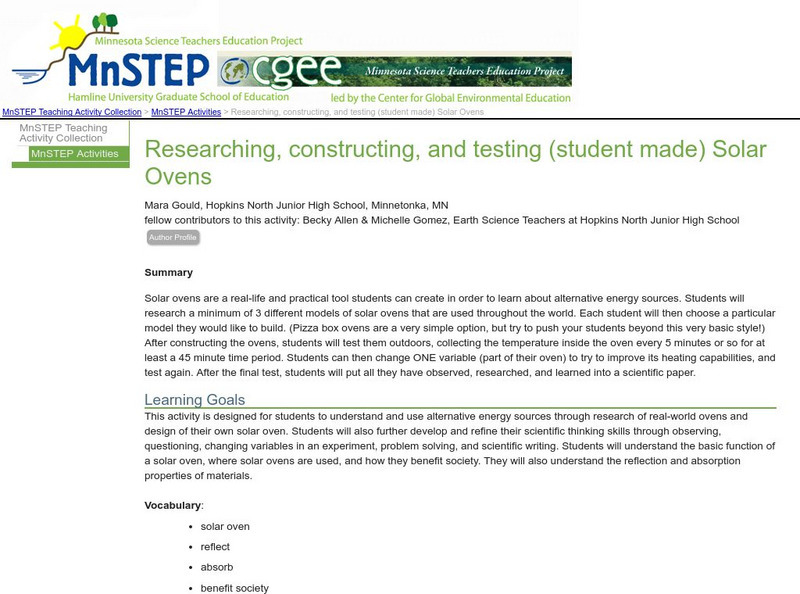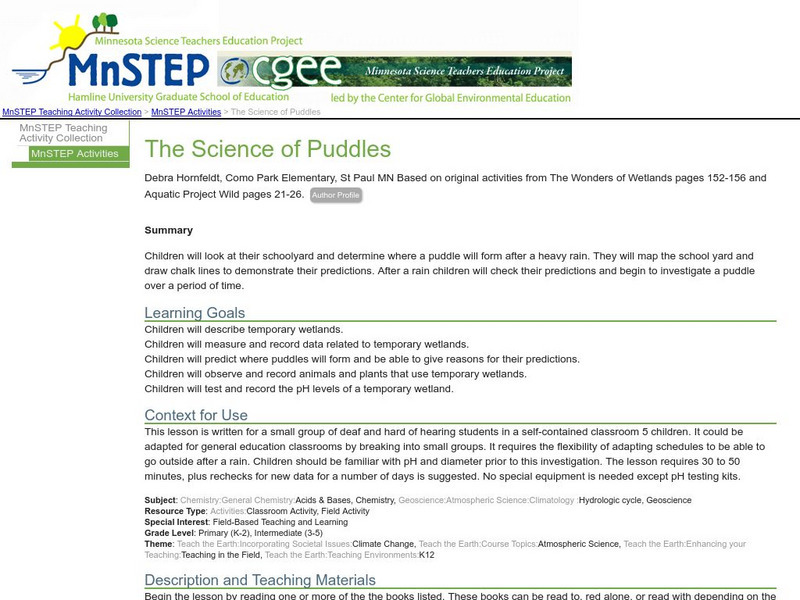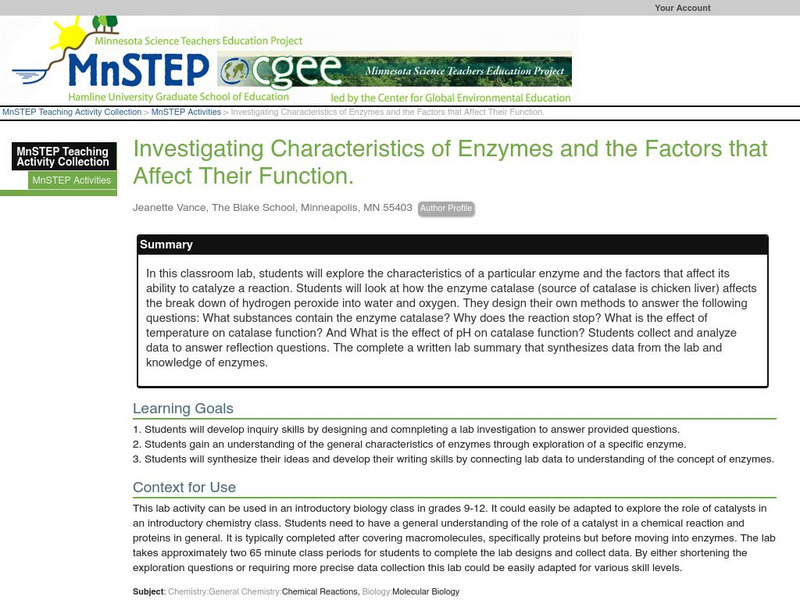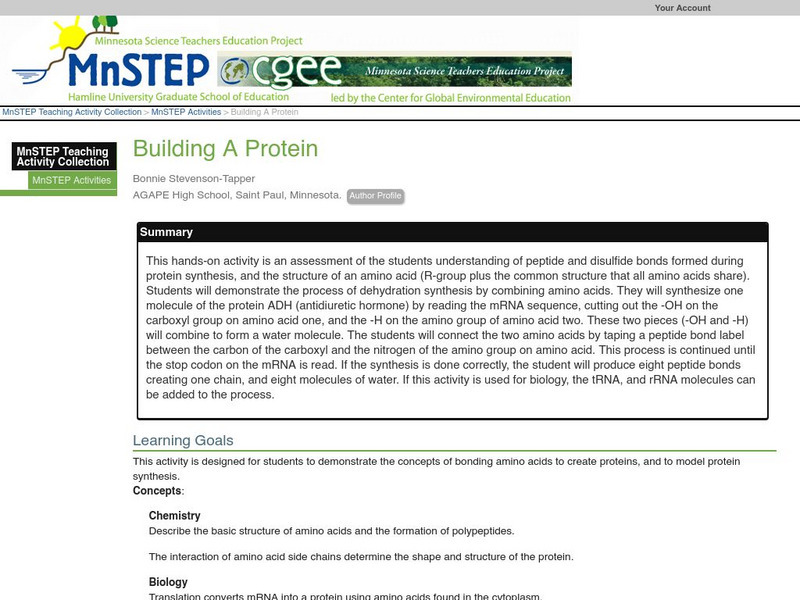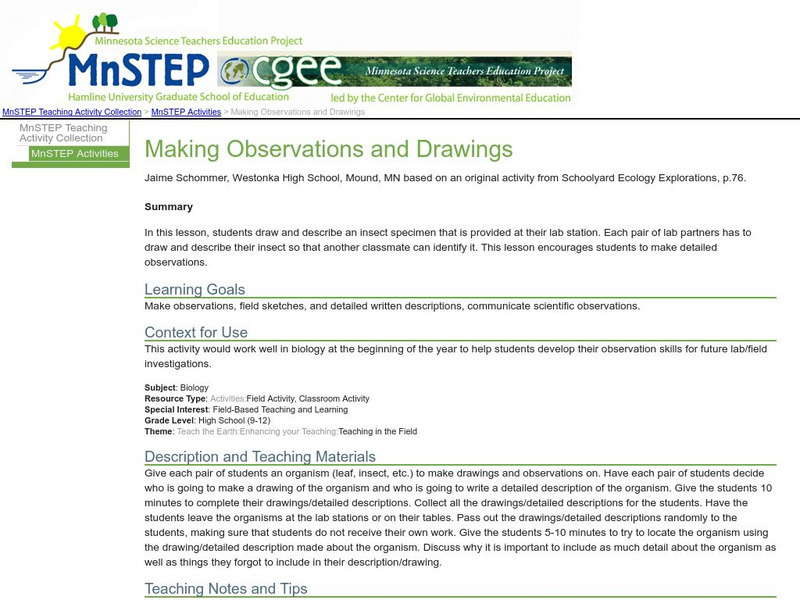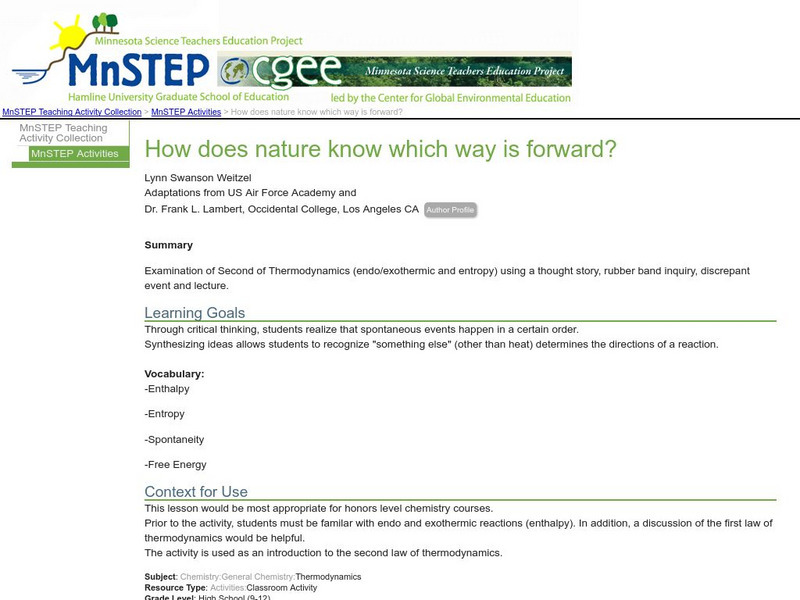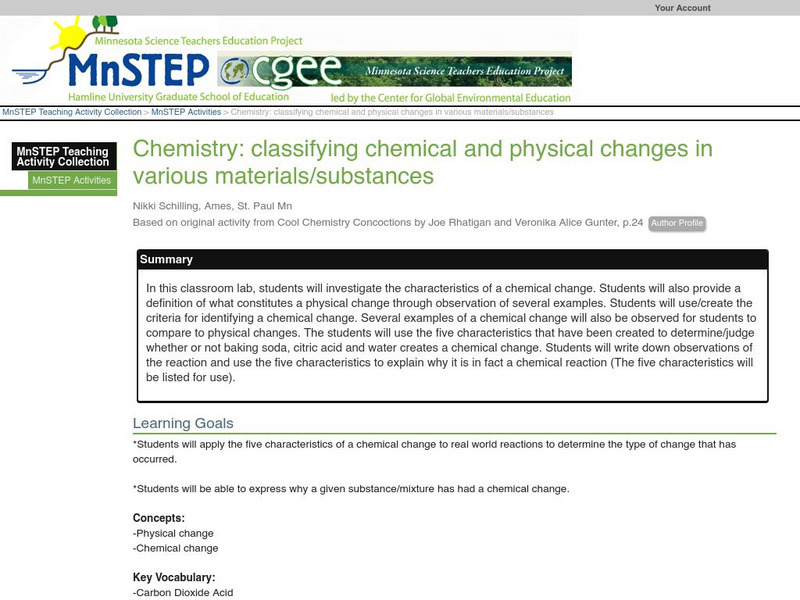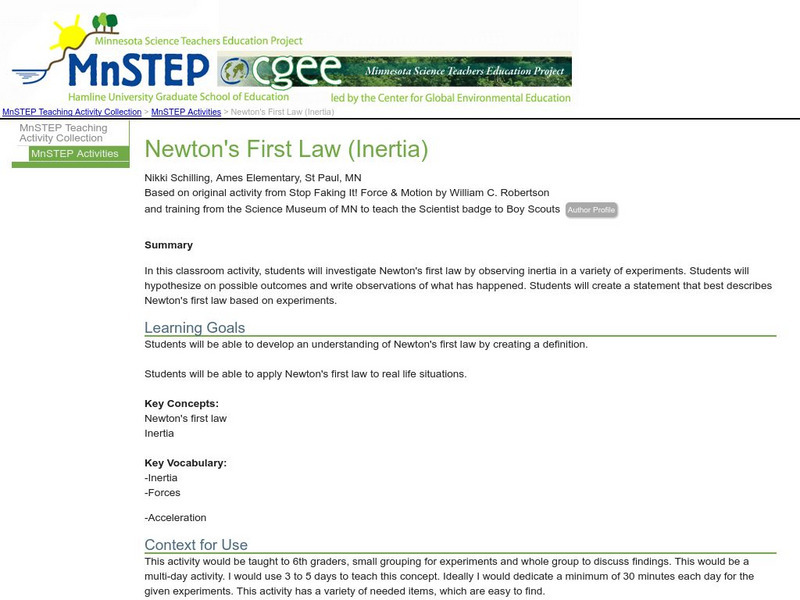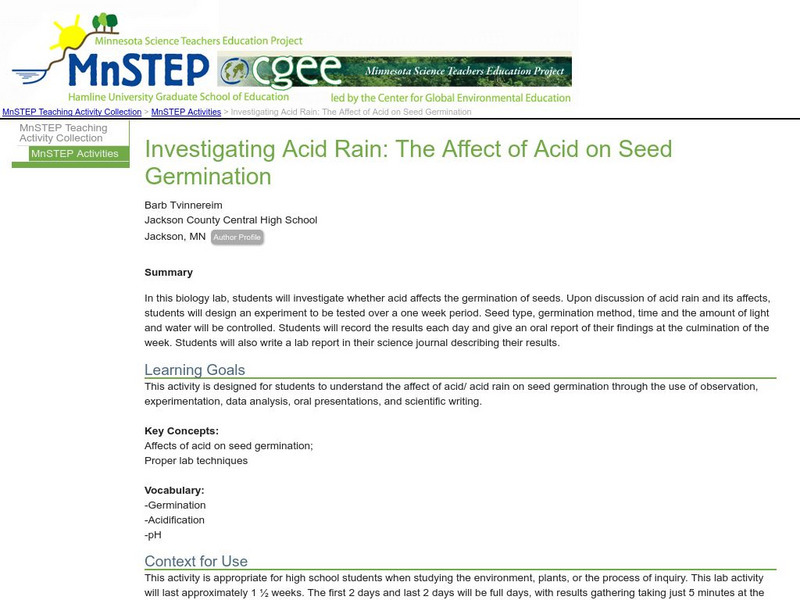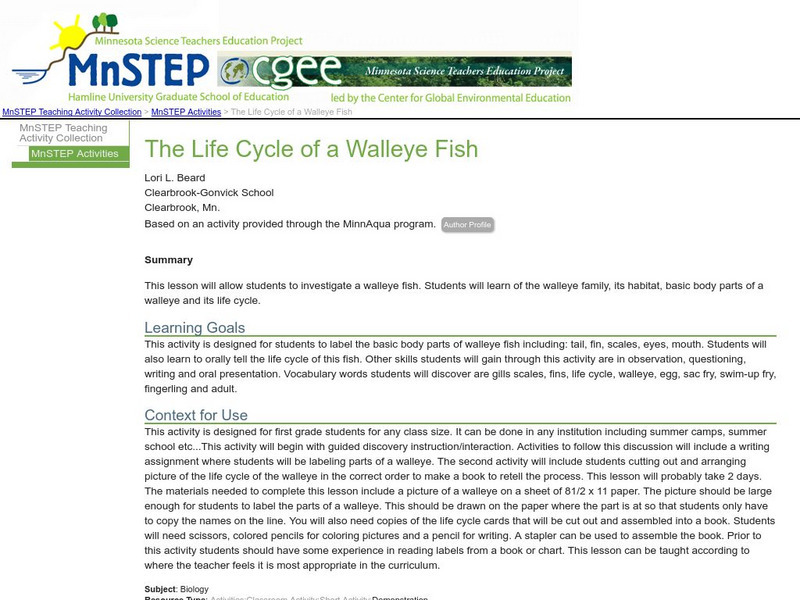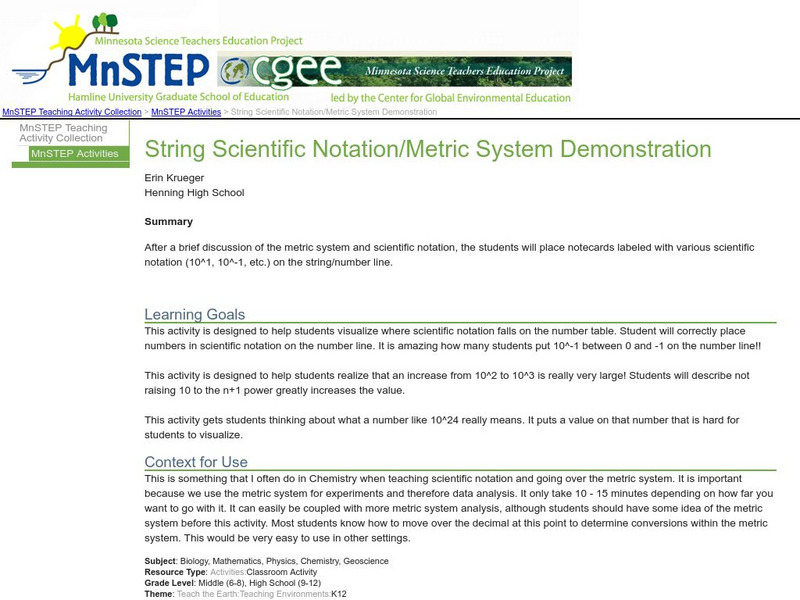Science Education Resource Center at Carleton College
Serc: Mn Step: Researching, Constructing, and Testing (Student Made) Solar Ovens
For this science investigation, students will research models of solar ovens, choose one design, and create it. Once built, they will test it outside and record the internal temperature at intervals. Next, they are to change on variable...
Science Education Resource Center at Carleton College
Serc: The Science of Puddles
Students will look at their schoolyard and determine where a puddle will form after a heavy rain. They will map the school yard and draw chalk lines to demonstrate their predictions. After a rain children will check their predictions and...
Science Education Resource Center at Carleton College
Serc: Investigating Characteristics of Enzymes & Factors That Affect Their Funct
By using inquiry skills, students will design and complete a lab investigation to gain an understanding of the concept of enzymes.
Science Education Resource Center at Carleton College
Serc: Hydrogen Oxygen Rockets
Students investigate how to build and launch a simple rocket that uses hydrogen and oxygen gases that will be mixed to propel the rocket. Students learn the principles of combustion reactions, kinetics, stoichiometry of reactions,...
Science Education Resource Center at Carleton College
Serc: Quantum Atomic Structure
This multi-day lesson plan helps students to understand how the models of the atom have changed and how quantum mechanics affects the electrons as they orbit the nucleus.
Science Education Resource Center at Carleton College
Serc: Group and Periodic Properties Lab
Students observe and perform experiments with sodium, potassium, calcium, magnesium, sulfur ,and phosphorus. The discover trends down groups, across periods, and having to do with the pH of metal oxides vs. nonmetal oxides.
Science Education Resource Center at Carleton College
Serc: Bending Light
In this physics lab students will observe light bending as it enters a medium. Students will then be able to calculate the angle of the bent light and compare that with other students observations for like and different mediums.
Science Education Resource Center at Carleton College
Serc: Building a Protein
This hands-on activity is an assessment of the students understanding of peptide and disulfide bonds formed during protein synthesis, and the structure of an amino acid (R-group plus the common structure that all amino acids share)....
Science Education Resource Center at Carleton College
Serc: Making Observations and Drawings
This lesson will help students develop their scientific observation skills and encourages students to make detailed observations. They will draw and describe insect specimens so another classmate can identify it.
Science Education Resource Center at Carleton College
Serc: Building 3 D Models of Atoms
Students build atoms of elements 1-20. The entire set can be hung from the ceiling in order of the Periodic Table to be referred to throughout the Chemistry class/unit. This is helpful when teaching bonding and patterns of the Periodic...
Science Education Resource Center at Carleton College
Serc: Calculating Air Resistance Using the Monte Carlo Method
Students will use Vernier motion detector and Logger Pro software to first discover if air resistance of an industrial size coffee filter is a vtm or vt2m relationship (vt = terminal velocity). Once this relationship is found it will be...
Science Education Resource Center at Carleton College
Serc: How Does Nature Know Which Way Is Forward?
Through critical thinking, students realize that spontaneous events happen in a certain order. This activity presents an examination of the Second Law of Thermodynamics using a thought story, rubber band inquiry, discrepant event and...
Science Education Resource Center at Carleton College
Serc: Goldenrod Gall Investigation
In this life science field investigation middle schoolers study goldenrod gall population.
Science Education Resource Center at Carleton College
Serc: Classifying Chemical and Physical Changes in Various Materials/substances
In this classroom lab, students will investigate the characteristics of a chemical change. Students will also provide a definition of what constitutes a physical change through observation of several examples. Students will use/create...
Science Education Resource Center at Carleton College
Serc: Newton's First Law (Inertia)
This activity provides learners an opportunity to investigate Newton's first law by observing inertia in a variety of experiments. Students will hypothesize on possible outcomes, write observations of what has happened, and apply...
Science Education Resource Center at Carleton College
Serc: Investigating Acid Rain: The Affect of Acid on Seed Germination
In this biology lab, students will investigate whether acid/acid rain affects the germination of seeds through the use of observation, experimentation, data analysis, oral presentations, and scientific writing.
Science Education Resource Center at Carleton College
Serc: Tree Leaf Identification and Leaf Display Activity
In this Biology field activity, students collect tree leaves and seeds to make an identified collection after drying in a plant press, a phone book, or in magazines.
Science Education Resource Center at Carleton College
Serc: Do All Types of Lights Follow Ohm's Law?
For this physics lab students investigate whether Ohm's Law applies to common electric devices. Students submit their findings in a written report or class discussion.
Science Education Resource Center at Carleton College
Serc: Mn Step: The Life Cycle of a Walleye Fish
The walleye fish is the subject of this instructional activity where students learn and describe the parts of its body and its life cycle.
Science Education Resource Center at Carleton College
Serc: Design an Experiment Testable on 50 People Dealing With Your 5 Senses
Students design an investigation about one of the five senses using the process of the scientific method.
Science Education Resource Center at Carleton College
Serc: Mn Step: Study of Student Precision Using Volumetric Glassware
This activity is an exercise in using various lab equipment for measuring the volume of a liquid. Data is recorded on a spreadsheet and analyzed to see which tool offers the greatest precision.
Science Education Resource Center at Carleton College
Serc: Mn Step: Where Shall We Go Swimming?
After analyzing samples of water from local lakes, young scholars will perform tests on water from two locations, compare the results, and complete a lab report. They will then examine maps to determine factors that may have had an...
Science Education Resource Center at Carleton College
Serc: Mn Step: Seeds to Plants: How to Grow a Plant
An experiment where first-graders plant seeds and monitor their growth. Prior to planting, they decide on an inquiry question, and how they will find out the answer through the experiment.
Science Education Resource Center at Carleton College
Serc: Mn Step: String Scientific Notation/metric System Demonstration
An activity where students must order cards labeled with scientific notation on a number line. The purpose is to ensure that they comprehend how raising the power of ten even by one has a very big effect on the value.


